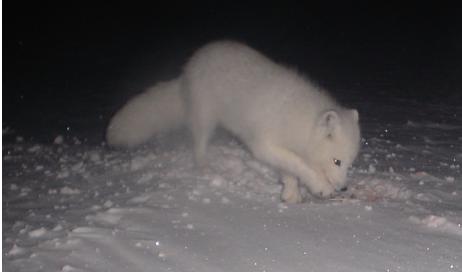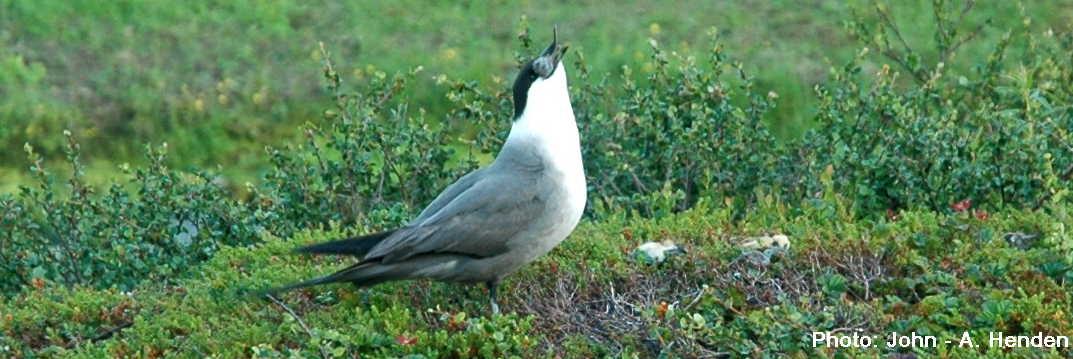Changing population dynamics and effects on species viability and interaction strength: A modelling approach Ph.D-Project: John-A. Henden |
|
Small mammal population dynamics and potential effects on predators |
|
Most predators are closely related to the dynamics of their preferred prey species. If the dynamics of these prey species change, one would expect some effects to be transferred to the next trophic level, i.e. to the dynamics of their predator |
|
Arctic fox on Varanger penninsula |
|
One that has received considerable attention in recent years is the Arctic fox ( Alopex lagopus ) in Fennoscandia, which is now considered close to regional extinction. S everal, hypotheses have been proposed as for the cause of the decrease, but our focus has been to assess whether the observed changes in the dynamics of small rodent is a plausible explanation for the decrease and non-recovery of Fennoscandian Arctic fox populations. Additionally, in the wake of the latest decrease in Arctic fox populations in Scandinavia , several conservation programs were initiated to increase viability. These conservation actions include artificial feeding trials, artificial breeding and reintroduction and removal of a dominant competitor, the Red fox. However, less emphasis has been directed towards an assessment of the potential success of these programs, i.e. which vital rates these actions affect, how much and when in the cycle of arctic fox dynamics they would inflict the greatest affect. Thus, we are interested in investigating to which vital rates the different conservation programs deployed in Scandinavia today likely affect and when in the cycle (i.e. phases) they might have the largest impact. Further, we want to evaluate the magnitude of change necessary to assure population viability. |
|
Species interactions |
|
One of the central themes in community ecology is the examination of interactions between species. Evaluating the strength of interactions among species is an important step in understanding the structure of natural communities and predicting how they will respond to changes in the biotic environment. Thus, an accurate measure of interaction strength can aid researchers and wildlife managers in focusing on the most likely effects instead of the vast range of possible outcomes. Most species interactions, both pairwise and those embedded in complex food webs, are described in terms of the concept of interaction strength. Most measures of interaction strength rely upon equilibrium concepts, i.e. changes in carrying capacity, the effects of changes in density of one species on another species density etc. However, such measures might be difficult to apply in practise for a system with cyclic dynamics. The concept of interaction strength, however, has a host of different definitions and a large variety of empirical approaches have been applied to determine its magnitude. As a result, there has been a huge gap between what theoreticians have defined as metrics of interaction strength and what researchers have actually measured in nature. The great diversity of approaches and definitions complicates comparative analysis of interactions in food webs . Thus, our focus has been to investigate how one might assess interaction strengths in a cyclic system, with focus on predator-prey models. We want to compare different metrics of interaction strength to evaluate what kind of information the different measures give and their comparability. Further, we want to study the temporal variation in interaction strength in relation to the current sampling schemes of small mammals, i.e. how representative are the sampling times of small mammals and their interactions in nature to the general strength of interactions in model food webs. This work is based on simulations of a mathematical model with lemming as the key-stone species connected to one specialist and tree generalist predators with differing numerical and functional responses. Furthermore, interaction strength and other ecosystem descriptors (e.g. connectance) are usually estimated without taking into account uncertainties in underlying parameters (consumption rates, densities or precence/absence data). We will investigate how sensitive different measures of interaction strength are to uncertainties in the underlying parameters (especially bias), and how one might correct for such uncertainties. |
|
Long tailed skua eating root vole |
|
 s. Both Lemming ( Lemmus lemmus ) and voles (Microtus sp. and Clethrionomys sp.) have been considered crucial for both avian and mammal predators in most of their range. Such small rodents have been well known for their cyclic population dynamics with peaks in density every 4-5 years. However, while regular cycles were a common sight until the late 1970's in Fennoscandia, drastic large-scale changes in their population dynamics occurred in the 80's onward. Regular cycles have disappeared and the dynamics have become more dampened. Consequently, these changes in small rodent dynamics have been accompanied by large changes in the dynamics and distribution of several of their predators.
s. Both Lemming ( Lemmus lemmus ) and voles (Microtus sp. and Clethrionomys sp.) have been considered crucial for both avian and mammal predators in most of their range. Such small rodents have been well known for their cyclic population dynamics with peaks in density every 4-5 years. However, while regular cycles were a common sight until the late 1970's in Fennoscandia, drastic large-scale changes in their population dynamics occurred in the 80's onward. Regular cycles have disappeared and the dynamics have become more dampened. Consequently, these changes in small rodent dynamics have been accompanied by large changes in the dynamics and distribution of several of their predators. 